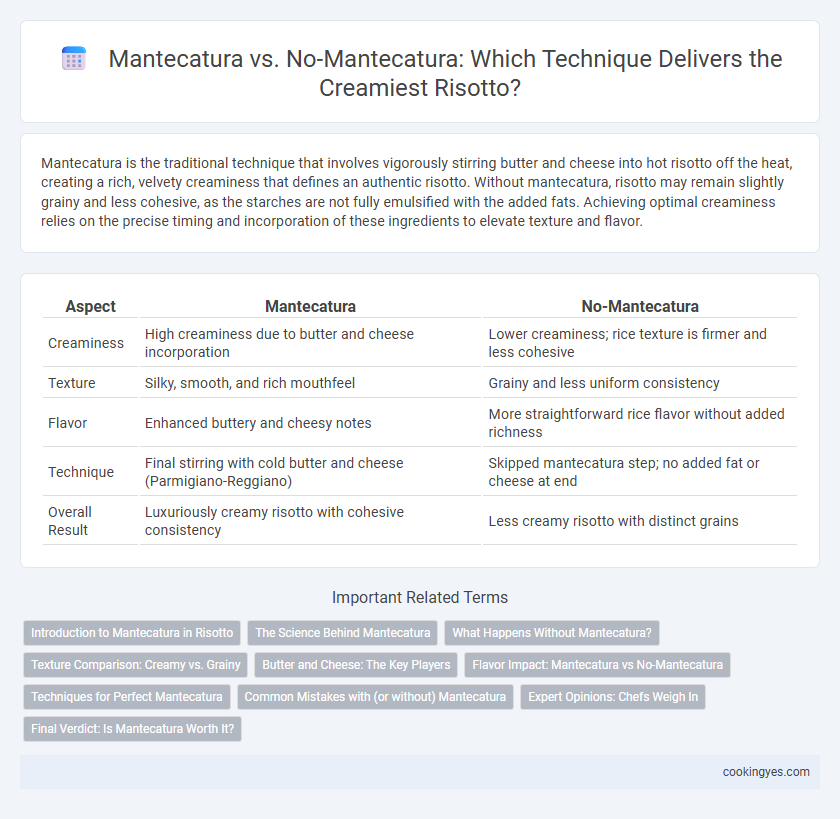Mantecatura is the traditional technique that involves vigorously stirring butter and cheese into hot risotto off the heat, creating a rich, velvety creaminess that defines an authentic risotto. Without mantecatura, risotto may remain slightly grainy and less cohesive, as the starches are not fully emulsified with the added fats. Achieving optimal creaminess relies on the precise timing and incorporation of these ingredients to elevate texture and flavor.
Table of Comparison
| Aspect | Mantecatura | No-Mantecatura |
|---|---|---|
| Creaminess | High creaminess due to butter and cheese incorporation | Lower creaminess; rice texture is firmer and less cohesive |
| Texture | Silky, smooth, and rich mouthfeel | Grainy and less uniform consistency |
| Flavor | Enhanced buttery and cheesy notes | More straightforward rice flavor without added richness |
| Technique | Final stirring with cold butter and cheese (Parmigiano-Reggiano) | Skipped mantecatura step; no added fat or cheese at end |
| Overall Result | Luxuriously creamy risotto with cohesive consistency | Less creamy risotto with distinct grains |
Introduction to Mantecatura in Risotto
Mantecatura is the traditional Italian technique of vigorously stirring cold butter and finely grated Parmesan cheese into risotto just before serving, creating a rich, creamy texture that enhances flavor and mouthfeel. Without mantecatura, risotto tends to be less cohesive and lacks the characteristic silkiness, resulting in a drier, grainier experience. The emulsification process during mantecatura binds the starch released by the arborio or carnaroli rice, producing the signature creamy consistency essential to authentic risotto.
The Science Behind Mantecatura
Mantecatura is a crucial technique in risotto preparation that significantly enhances creaminess through the emulsification of starch released from the rice with butter and cheese. This process creates a smooth, velvety texture by binding water molecules to starch granules, which cannot be replicated by simply cooking risotto without mantecatura. Scientific studies show that mantecatura optimizes the release and integration of amylopectin, the starch component responsible for the characteristic rich mouthfeel of authentic risotto.
What Happens Without Mantecatura?
Without mantecatura, risotto lacks its signature creamy and velvety texture, resulting in a grainy and dry consistency. The absence of this final stirring step with cold butter and cheese prevents the starch granules from fully emulsifying, causing the liquid to separate rather than bind smoothly. Consequently, the rice grains remain distinct and less cohesive, diminishing the overall richness and mouthfeel characteristic of traditional risotto.
Texture Comparison: Creamy vs. Grainy
Mantecatura transforms risotto by stirring in butter and cheese at the end, creating a rich, velvety texture that enhances creaminess and cohesion between grains. Without mantecatura, the risotto retains a more distinct grain structure, resulting in a grainier, less creamy mouthfeel. The contrast in texture highlights the critical role of mantecatura in achieving the signature smoothness characteristic of traditional risotto.
Butter and Cheese: The Key Players
Butter and cheese are essential to risotto's signature creaminess, as they emulsify the starches released during cooking to create a smooth, velvety texture. Mantecatura involves vigorously stirring butter and grated cheese into hot risotto off the heat, which enhances the dish's richness and silkiness. Without mantecatura, risotto tends to be less creamy and more watery, lacking the cohesive, luxurious mouthfeel that perfectly balanced butter and cheese provide.
Flavor Impact: Mantecatura vs No-Mantecatura
Mantecatura, the technique of vigorously stirring butter and cheese into risotto just before serving, intensifies creaminess and enriches flavor by emulsifying fats with starchy rice. Without mantecatura, risotto tends to have a firmer texture and a less pronounced savory depth, resulting in a more straightforward but less luxurious taste. The flavor impact of mantecatura is a velvety mouthfeel combined with a harmonious blend of dairy and umami notes, crucial for authentic Italian risotto.
Techniques for Perfect Mantecatura
Mantecatura, the Italian technique of vigorously stirring Risotto off heat with cold butter and grated Parmesan, transforms the dish into a creamy, velvety delight by emulsifying starch and fat molecules. Skipping mantecatura results in a less cohesive texture, as the starch is not fully released and integrated, leading to a drier, grainier Risotto. Mastering mantecatura requires timing the addition of butter and cheese just before serving and using continuous, rapid stirring to achieve the signature luxurious creaminess without overcooking the grains.
Common Mistakes with (or without) Mantecatura
Mantecatura, the technique of vigorously stirring in butter and cheese off heat, is essential for achieving the signature creamy texture of risotto by emulsifying starches released during cooking. Common mistakes include skipping mantecatura, resulting in a grainy, dry texture, or over-mixing, which breaks down the rice grains and creates a gummy consistency. Using cold butter or adding cheese too early can also inhibit proper emulsification, preventing the risotto from developing its characteristic velvety creaminess.
Expert Opinions: Chefs Weigh In
Expert chefs universally endorse mantecatura as the essential technique for achieving risotto's hallmark creaminess, emphasizing the importance of slowly stirring in cold butter and finely grated Parmesan off heat to create an emulsified, velvety texture. Critics of no-mantecatura methods argue that omitting this step results in a drier, less cohesive dish lacking the signature richness that defines authentic risotto. Culinary authorities like Massimo Bottura and Gennaro Contaldo highlight mantecatura as the final flourish that transforms perfectly cooked rice into a creamy, luxurious experience resonating with traditional Italian excellence.
Final Verdict: Is Mantecatura Worth It?
Mantecatura significantly enhances the creaminess of risotto by incorporating butter and cheese at the end of cooking, creating a rich, velvety texture that no-mantecatura risotto lacks. This technique emulsifies the starches released during cooking, resulting in a cohesive and indulgent mouthfeel that elevates the dish's overall quality. For those seeking authentic and luscious risotto, mantecatura is worth the extra effort, delivering a superior dining experience compared to skipping this final step.
Mantecatura vs No-Mantecatura for Creaminess Infographic

 cookingyes.com
cookingyes.com